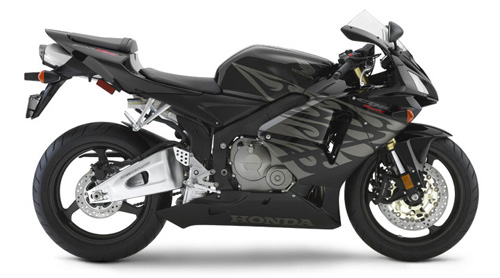Refining Honda Style
By Staff Writer

It has been only a year since the Honda CBR600RR burst onto the 600cc sportbike scene, capturing the 2004 AMA Formula Xtreme crown along the way. So what is in store for 2005? Try even greater horsepower, an all-new inverted front fork, lighter weight, CBR1000RR-style swingarm and front brakes, and scorching new bodywork.
Change forces change. What looks like the same frame is actually a completely new part that was cast with thinner walls but re-engineered to retain the previous rendition’s excellent rigidity. The frame alone makes up for 3.6lbs of an overall reduction of 9lbs. Further weight savings were gained with the redesign of many other components including the subframe, swingarm, exhaust, axles, side stand, rear shock and the gull-wing top triple-clamp.
Further subtleties were applied toward the engine too. The 05′ gets a revised dual stage fuel injection with new injectors injecting. The motor features reshaped ports with a narrower venturi section to accelerate cylinder fuel fill. New mapping caters to that and exhaust changes too and power is up, particularly in the midrange.
The bike offers more precise handling due to the compact engine length and thinner wall sections. Hidden away beneath the swoopy new bodywork, the CBR600RR powerplant retains the same basic architecture—a 599cc, liquid-cooled, fuel-injected, in-line and four cylinder—that redlines at 15,000 rpm. This engine is amazingly compact because of a layout that places the mainshaft above the crankcase split line. Thus, allowing the countershaft to move closer to the crankshaft. The CBR600RR’s fine die-cast aluminum frame is still manufactured using innovative casting methods to provide optimum rigidity and flex characteristics where needed.
The bike has the ability to run deeper into corners on minimal braking due to the fantastic stability of the new front end. The new 41mm inverted forks are obviously smaller than last year’s 45mm and offer a saving in unsprung weight. They feature Honda’s own HMAS cartridge internals and have the usual compression, damping and rebound.
The new brakes garnish praise, too. These new Tokico radial-mounted calipers offer nice feel and were quite powerful. It seems such a minor change to the front brake set-up but the pay back is great. These particular brakes are very progressive with not too much squeeze effort needed to work. With this combination of 310mm floating rotor, forks and brakes, deep trail braking into corners is a breeze and will quite obviously offer you a quicker way around your favorite race track.
The back end of the bike features the MotoGP derived Unit Pro-Link and has a redesigned swingarm. The shock linkage is now incorporated into the design of the swinger, rather than a few separate cast pieces and the whole kit and caboodle is lighter and more compact. Another upside is easier access and fewer parts to deal with. It is a handsome swingarm set-up and very purposeful looking, especially with no exhaust covering it up.
Walking around the outside of the bike, you can not help notice that the new bike is better looking than the old one. Again, the differences are very subtle with revised aerodynamics and an even more pronounced RC211V look. The rear seat unit also has a slightly slimmed down look, again very subtle, but groovier. Paintwork is typical Honda glossy good with a tribal wing design that looked fresh and up to the minute. If you are not into graphics, but into black, there is a blacked out graphic-free bike for your enjoyment. Honda has different paint options to offer on the CBR-RR (old and new) plus, the Honda wing logo really suits the slabby bodywork on the newer CBR range.
Although it looks similar, instrumentation is new, too…again more dieting with a nice slim clock design. The look is all business, too, with that large tachometer dominating your eye and a couple of LCD screens offering a mixture of speed, gas, coolant temperature, petrol gauge, and the dual tripmeter is digitized within. Similarity seems to be the name of the game here, in fact, the only way you could really tell between the old and new bike was the fact that the new bike had a smaller exhaust hole.
So what we have here is a better suspended, lighter and quicker braking 2005 model. Nothing unexpected, shocking or radical, just the Honda style of refinement in-between model years!
